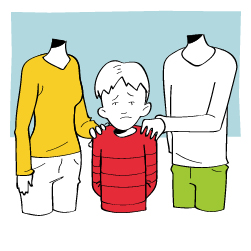Differentiation therapy & PHASE therapy
Differentiation therapy & phase /adoption-supporttherapy are both types of therapy for children and young people suffering from attachment issues. The treatment involves the parent(s), guardian(s) or permanent carer(s) (such as group leaders).
Corrective experiences are obtained in the areas of care, trusting other people and thoughts about yourself in a controlled and phased manner.
Deze pagina is hier in het Nederlands beschikbaar.
In differentiation therapy, a child or young person is encouraged to feel all kinds of details, such as soft, warm, cold, salt, sweet, etc. Attachment problems commonly cause these perceptions to be left desensitised because they may evoke painful memories or because they are insufficiently developed. During this period, in the home situation attention is devoted to a stable environment and the limitation of behavioural problems through Therapeutic Parenting.

Phase therapy can be initiated after differentiation therapy has been concluded. For each stage of life of children and young people (baby, toddler, infants, primary school) the needs and suitable types of nearness are explored. After this, children can re-enact this with their parents or guardians using homework assignments. ‘Being together’ is targeted in a playful manner, and it can usually be introduced in existing daily practices, the difference being that they are now provided with an additional focus. The structure of the therapy ensures it can be easily and securely carried out by both children and parents. Experiences are further elaborated during moments of contact with the therapist, and regular contacts with the parents or guardians are scheduled.
After concluding the nearness phases, a follow-up is initiated which involves attention to skills, learning how to deal with others from understanding, and self-esteem.
Differentiation therapy & phase therapy require a certain amount of commitment from the child/young person, parents/guardians and therapist, and we will have to collaborate properly on a regular basis. Depending on the child’s or young person’s age, the therapy commonly takes more than two years and consecutive follow-up contacts. The therapy takes place in conjunction with the parent(s), guardian(s) or mentor. During the initial phase, contacts take place on a regular basis; frequency is adapted depending on the course of treatment. We also take daily events and circumstances into account and may put therapy on hold for a while if too many things are taking place in daily life.
This therapy involves insights from attachment theories, neuropsychology, trauma therapy, cognitive-behavioural therapy, experiential psychotherapy, and other therapies.
Refer to www.hechtingsproblemen.nl and kenniscentrum KJP for more information.

 Therapeutic Parenting
Therapeutic Parenting Adoption support
Adoption support Attachment disorder
Attachment disorder Differentiation therapy & PHASE therapy
Differentiation therapy & PHASE therapy FASD Support
FASD Support CONNECT parentgroup The Netherlands
CONNECT parentgroup The Netherlands FASD
FASD